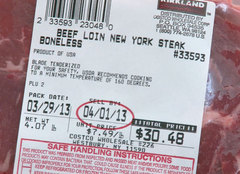
Federal regulators have moved a step closer toward requiring mechanically tenderized beef to be labeled so that you are better informed about what you buy and how to cook it safely.
The tenderizing process can drive bacteria such as the deadly pathogen E. coli O157:H7 from the surface deep into the center of the meat, which can increase the risk of illness for people who eat that beef rare or medium-rare. As we reported in "Has Your Steak Been Mechanically Tenderized?" the blades or needles used in this process leave no telltale signs, so you can't tell just by looking whether a piece of beef has been mechanically tenderized and therefore needs to be cooked more thoroughly for safety's sake.
For several years, Consumers Union, the policy and advocacy arm of Consumer Reports, has been calling for labels that disclose that beef has been mechanically tenderized and include cooking instructions. "Putting a label on mechanically tenderized meat that also includes cooking instructions is a commonsense step that will help protect consumers and their families from unnecessary and possibly serious illness," says Ami Gadhia, senior policy counsel for Consumers Union.
Consumers Union has questions about recommended cooking temperatures in the U.S. Department of Agriculture's proposed rule, however. The proposal contains examples that suggest that grilling steaks to an internal temperature of 145° F and then allowing the meat to rest for at least three minutes before serving would be adequate. Those instructions are the same as current federal cooking recommendations for intact, nontenderized steaks and less stringent than the 160° F minimum temperature recommended for ground-beef patties. "We are pleased that the proposed rule has been released and look forward to learning from the USDA how it came to its cooking temperature recommendation," Gadhia says.
In contrast to USDA proposals, Canadian government officials last month announced that all federally registered plants that produce mechanically tenderized beef will be required to label that meat as such and include safe-cooking instructions. Health Canada recommends cooking mechanically tenderized beef to an internal temperature of at least 160° F. Not only must meat-processing plants comply by July 2, 2013, but Canadian regulators also stated that they plan to propose mandatory labeling at retail outlets such as supermarkets; some grocers began doing so voluntarily in 2012.
In the U.S., however, you're likely to have a much longer wait before you see mandatory labels appear on mechanically tenderized beef. (Currently, you'll also see other terms such as "blade tenderized" or "needled.") The USDA is seeking comments on the proposed labeling rule over the next 60 days; after that the rule must then undergo further review by both USDA and the Office of Management and Budget and might not be finalized until sometime in 2014.
brightcove.createExperiences();





